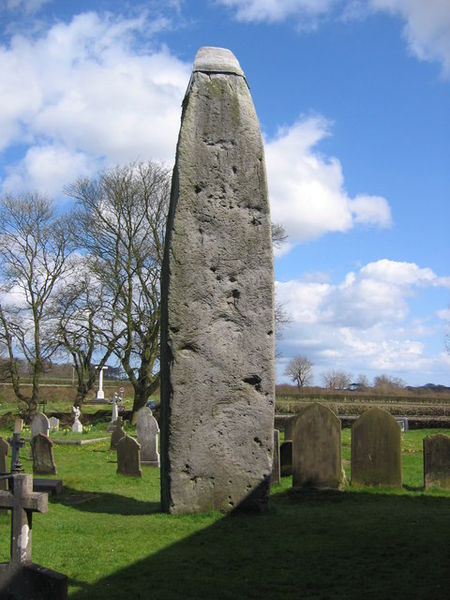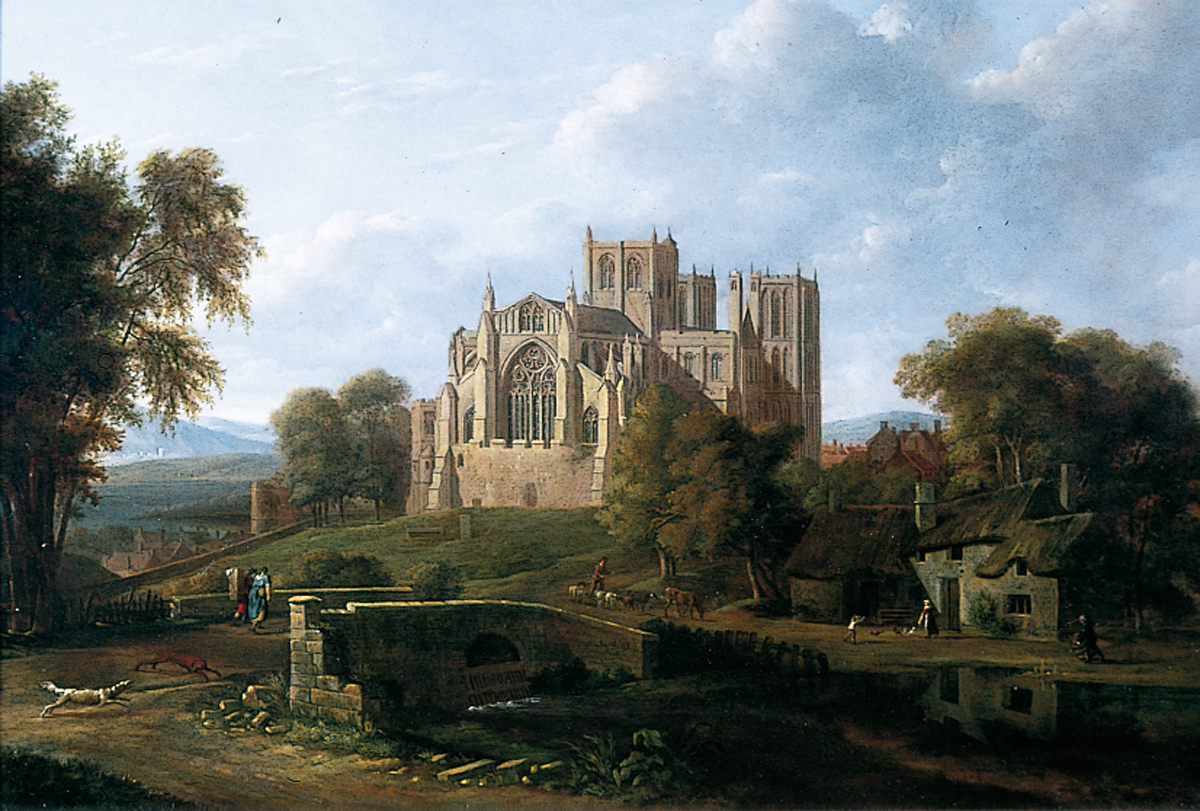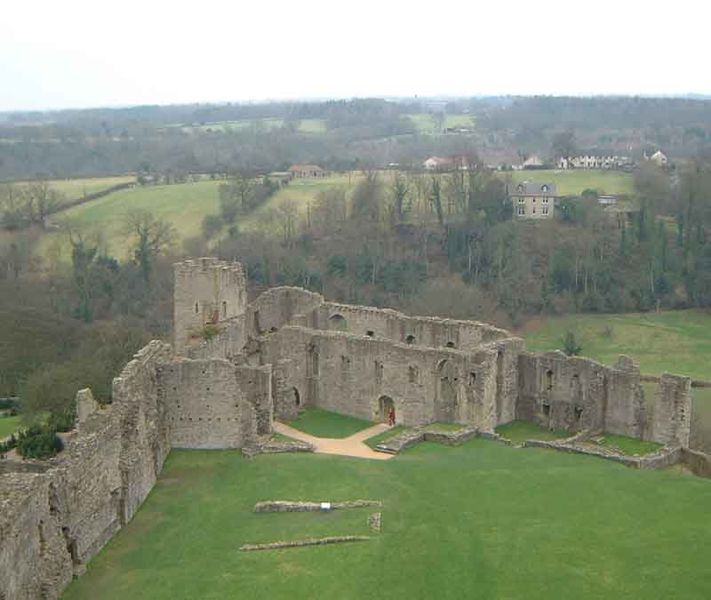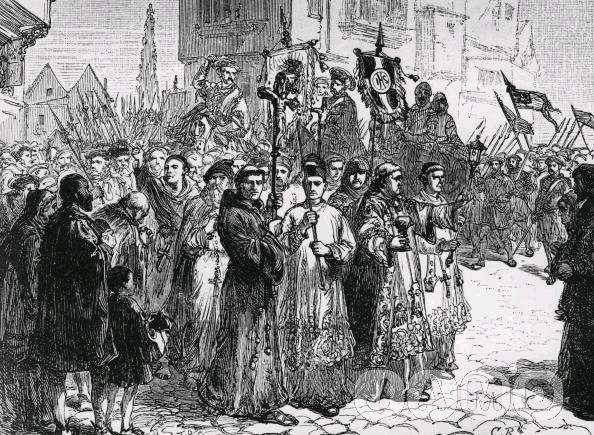
The history of Yorkshire is one of the richest of any English county, typically centred on the county town of York. The region was first occupied after the retreat of the ice age around 8000 BC. During the first millennium AD it was occupied by many different factions including the Romans, Angles and Vikings. The name comes from "Eborakon" (c. 150) an old Brythonic name which probably derives from "Efor" or "the place of the yew-trees." Many Yorkshire dialect words and aspects of pronunciation derive from old Norse due to the Viking influence in this region. The name "Yorkshire", first appeared in writing in the Anglo-Saxon Chronicle in 1065. It was originally composed of three sections called Thrydings, subsequently referred to as Ridings.
Following the Norman Conquest of England in 1066, Yorkshire was subject to the punitive harrying of the North, which caused great hardship. The area proved to be notable for uprisings and rebellions through to the Tudor period. During the industrial revolution, the West Riding became the second most important manufacturing area in the United Kingdom, while the predominant industries of the East and North Ridings remained fishing and agriculture. In modern times, the Yorkshire economy suffered from a decline in manufacturing which affected its traditional coal, steel, wool and shipping industries. In Yorkshire there is a very close relationship between the major topographical areas and the underlying geology. The Pennine chain of hills in the west is of Carboniferous origin. The central vale is Permo-Triassic. The North York Moors in the north-east of the county are Jurassic in age while the Yorkshire Wolds to the south east are Cretaceous chalk uplands. The region is drained by several rivers. In eastern and central Yorkshire the many rivers empty their waters into the River Ouse which reaches the North Sea via the Humber Estuary.
The Prehistoric Era
This includes any events up until arrival of the Romans, c.71 AD in this area.
 The appearance of the terrain differed greatly from that which exists today. During the early part of this period there was a land connection between what is now Germany and eastern England, making it possible for groups of hunters to wander into the area. When the first people arrived, the climate would have been sub arctic and the animals that the Paleolithic groups found would have been included the mammoth, woolly rhinoceros and reindeer. Evidence of human activity in Yorkshire itself is, so far, restricted to that revolving around a hunter gatherer lifestyle dating from around 8000/7000 BC. In Victoria Cave, Settle, late upper palaeolithic projectile points were found that include the bone head of a harpoon which was dated to within 110 years of 8270 BC.
The appearance of the terrain differed greatly from that which exists today. During the early part of this period there was a land connection between what is now Germany and eastern England, making it possible for groups of hunters to wander into the area. When the first people arrived, the climate would have been sub arctic and the animals that the Paleolithic groups found would have been included the mammoth, woolly rhinoceros and reindeer. Evidence of human activity in Yorkshire itself is, so far, restricted to that revolving around a hunter gatherer lifestyle dating from around 8000/7000 BC. In Victoria Cave, Settle, late upper palaeolithic projectile points were found that include the bone head of a harpoon which was dated to within 110 years of 8270 BC.
During the 5,000 years following the arrival of the first migrants the climate improved steadily and a richer natural vegetation started to cover the land including birch, hazel, elm, pine and oak trees. By 5000 B,C Britain was separated from mainland Europe after rising sea levels had created the southern area of the North Sea. Chapel Cave, near Malham in the northern Pennines, may have been used as a hunting lookout during the Mesolithic period. Animal bones which were found there included hare, fox, roe deer, badger and large birds. Fish scales, particularly perch, were also found. Further south, the Marsden area of the Pennines also became a seasonal hunting ground for early humans in the Mesolithic period. There were seasonal hunting encampments on the high ground by 7000 BC. Stone Age tools have been found at Pule Hill, Warcock Hill, Standedge and March Hill.
On the North York Moors, relics of this early hunting, gathering and fishing community have been found as a widespread scattering of flint tools and the barbed flint flakes used in arrows and spears. The earliest known evidence of human presence in the area of the Vale of Pickering dates back to the Mesolithic period, around 7000 BC The most important remaining settlement of this period is that at Star Carr near Scarborough, where, due to waterlogged conditions, a considerable quantity of organic remains as well as flint tools, have survived. This is Britain’s best-known Mesolithic site.
The Roman Era
Roman Britain refers to those parts of the island of Great Britain controlled by the Roman Empire between 43 and 410 AD.
 Yorkshire was effectively part of the Roman Empire from 71 AD to about 410 AD. Initially, Roman advances in Britain stopped at the River Don, the southern boundary of the Brigantian territory. The Templeborough area of Rotherham, just south of the Don, takes its name from the remains of the Roman fort found here. This was first built in wood c. 55 AD, and was later rebuilt in stone. The territory remained independent until 69 AD, when the Ninth Legion under Quintus Petillius Cerialis moved in to quell civil war between Cartimandua and Venutius, bringing to an end to British rule in England. A fort at Danum (Doncaster), at a crossing over the River Don was built around 71 AD.
Yorkshire was effectively part of the Roman Empire from 71 AD to about 410 AD. Initially, Roman advances in Britain stopped at the River Don, the southern boundary of the Brigantian territory. The Templeborough area of Rotherham, just south of the Don, takes its name from the remains of the Roman fort found here. This was first built in wood c. 55 AD, and was later rebuilt in stone. The territory remained independent until 69 AD, when the Ninth Legion under Quintus Petillius Cerialis moved in to quell civil war between Cartimandua and Venutius, bringing to an end to British rule in England. A fort at Danum (Doncaster), at a crossing over the River Don was built around 71 AD.
The advancing Romans built roads northwards through the northern terrain to Eboracum (York), Derventio (Malton) and Isurium Brigantum (Aldborough) then onwards to Cataractonium (Catterick). Piercebridge in the Tees lowlands is the site of the fortified river crossing where Dere Street crossed the River Tees. York was founded in 71 AD as Eboracum, the Roman capital of Northern Britain and a fort was established there. There were still large areas of ill drained lowlands so the main routeways and settlements were built on higher ground on the Wolds and the edges of Holderness, the Vale of Pickering and the central Vales of Mowbray and York. The site of York and its access routes took advantage of the higher ground of the York moraine which crosses the vale from west to east.
The Sub-Roman Era
This spans from the departure of the Romans circa. 410 AD to the start of Danish supremacy in the area in 866 AD.
 At the end of Roman rule in the 5th century, Northern Britain may have come under the rule of Romano-British Coel Hen, the last of the Roman-style Duces Brittanniarum (Dukes of the Britons). However, the Romano-British kingdom rapidly broke up into smaller kingdoms and York became the capital of the British kingdom of Ebrauc. Most of what became Yorkshire fell under the rule of the kingdom of Ebrauc but Yorkshire also included territory in the kingdoms of Elmet and an unnamed region ruled by Dunod Fawr, which formed at around this time as did Craven.
At the end of Roman rule in the 5th century, Northern Britain may have come under the rule of Romano-British Coel Hen, the last of the Roman-style Duces Brittanniarum (Dukes of the Britons). However, the Romano-British kingdom rapidly broke up into smaller kingdoms and York became the capital of the British kingdom of Ebrauc. Most of what became Yorkshire fell under the rule of the kingdom of Ebrauc but Yorkshire also included territory in the kingdoms of Elmet and an unnamed region ruled by Dunod Fawr, which formed at around this time as did Craven.
In the late 5th century and early 6th century Angles from the Schleswig-Holstein peninsula began colonising the Wolds, North Sea and Humber coastal areas. This was followed by the subjugation of the whole of east Yorkshire and the British kingdom of Ebruac in about 560. The name the Angles gave to the territory was Dewyr, or Deira. Early rulers of Deira extended the territory north to the River Wear and about 600, Æthelfrith was able to unite Deira with the northern kingdom of Bernicia, forming the kingdom of Northumbria, whose capital was at Eoforwic, modern day York. A later ruler, Edwin of Northumbria completed the conquest of the area by his conquest of the kingdom of Elmet, including Hallamshire and Leeds, in 617. For the kingdom of Northumbria the Viking era opened in 793 with an attack on the monasterey at Lindisfarne. Danish Vikings crossed the North Sea to plunder the coast of Northumbria whilst Norwegians raided Orkney, the Western Isles and Ireland. Yngling King Ragnar Lodbrok led a Danish Leidang into Northumbria during the mid-9th century, but was captured and executed in a snake pit at the Anglian court. The Danes embarked on a mission of vengeance, but were also part of the greater Scandinavian imperialist movement. In 865 his eldest son Ivar the Boneless led younger sons in control of the army into landing at East Anglia, where they slew King Edmund the Martyr. After their landing in East Anglia, the Danes headed north and took York in 866, eventually conquering the whole of Northumbria and Kingdom of Strathclyde.
The Early Middle Ages
This period takes place between the Danish colonisation of 866 AD to the Battle of Stamford Bridge in 1066.
 After the Danish subjugation of the region, in 875 Guthrum became leader of the Danes and he apportioned lands to his followers; however most of the English population were allowed to retain their lands under the lordship of their Scandinavian conquerors. Ivar the Boneless became "King of all Scandinavians in the British Isles". The Danes changed the Old English name for York from Eoforwic, to Jorvik. The Vikings destroyed all the early monasteries in the area and took the monastic estates for themselves. Some of the minster churches survived the plundering and eventually the Danish leaders were converted to Christianity. In the late 9th century Jorvik was ruled by the Christian king Guthfrith. It was under the Danes that the ridings and wapentakes of Yorkshire and the Five Burghs were established. The ridings were arranged so that their boundaries met at Jorvik, which was the administrative and commercial centre of the region.
After the Danish subjugation of the region, in 875 Guthrum became leader of the Danes and he apportioned lands to his followers; however most of the English population were allowed to retain their lands under the lordship of their Scandinavian conquerors. Ivar the Boneless became "King of all Scandinavians in the British Isles". The Danes changed the Old English name for York from Eoforwic, to Jorvik. The Vikings destroyed all the early monasteries in the area and took the monastic estates for themselves. Some of the minster churches survived the plundering and eventually the Danish leaders were converted to Christianity. In the late 9th century Jorvik was ruled by the Christian king Guthfrith. It was under the Danes that the ridings and wapentakes of Yorkshire and the Five Burghs were established. The ridings were arranged so that their boundaries met at Jorvik, which was the administrative and commercial centre of the region.
The Norse-Gaels, Ostmen or Gallgaidhill became Kings of Jorvik after long contests with the Danes over controlling the Isle of Man, which prompted the Battle of Brunanburh. Then, in 954, King Eric I of Norway of the Fairhair dynasty was slain at the Battle of Stainmore by Anglo-Saxons and Edred of England began overlordship. Jorvik was the direct predecessor to the shire of York and received further Danish royal aids after the invasion and takeover of Jorvik by England, from the Munsö descendants, Sweyn II of Denmark right down to Canute IV of Denmark's martyrdom. Saint Olave's Church in York is a testament to the Norwegian influence in the area.
The Middle Ages
This begins after the Battle of Stamford Bridge in 1066 and continues to the start of the Tudor dynasty in 1485.
 In 1066, after the death of King Edward the Confessor, Yorkshire became the stage for two major battles that would help decide who would succeed to the throne. Harold Godwinson was declared King by the English but this was disputed by Harold Hardrada King of Norway and William Duke of Normandy. In the late summer of 1066 Harold Hardrada, accompanied by Tostig Godwinson, took a large Norwegian fleet and army up the Humber towards York. They were met by the army of the northern earls Edwin of Mercia and Morcar of Northumbria who they defeated at the Battle of Fulford. Harold Hardrada occupied York and the Norwegian Army encamped at Stamford Bridge. Harold Godwinson had to travel from London gathering his army as he went to face the invasion. Within five days, on 25 September 1066, Harold Godwinson had reached Stamford Bridge and defeated the Norwegian Army in a battle in which both Harold Hardrada and Tostig Godwinson were killed. The battle at Stamford Bridge can be seen as one of the pivotal battles in English history, it was the last time a Scandinavian army was able to seriously threaten England. On 28 September William Duke of Normandy landed on the south coast of England forcing Harold Godwinson to rush south from Yorkshire with his army. They met at the Battle of Hastings where the English army was defeated and Harold Godwinson killed, allowing William to become King of England.
In 1066, after the death of King Edward the Confessor, Yorkshire became the stage for two major battles that would help decide who would succeed to the throne. Harold Godwinson was declared King by the English but this was disputed by Harold Hardrada King of Norway and William Duke of Normandy. In the late summer of 1066 Harold Hardrada, accompanied by Tostig Godwinson, took a large Norwegian fleet and army up the Humber towards York. They were met by the army of the northern earls Edwin of Mercia and Morcar of Northumbria who they defeated at the Battle of Fulford. Harold Hardrada occupied York and the Norwegian Army encamped at Stamford Bridge. Harold Godwinson had to travel from London gathering his army as he went to face the invasion. Within five days, on 25 September 1066, Harold Godwinson had reached Stamford Bridge and defeated the Norwegian Army in a battle in which both Harold Hardrada and Tostig Godwinson were killed. The battle at Stamford Bridge can be seen as one of the pivotal battles in English history, it was the last time a Scandinavian army was able to seriously threaten England. On 28 September William Duke of Normandy landed on the south coast of England forcing Harold Godwinson to rush south from Yorkshire with his army. They met at the Battle of Hastings where the English army was defeated and Harold Godwinson killed, allowing William to become King of England.
King William I and the Normans did not immediately gain control over the whole of the country and rebellions in the north of England, including Yorkshire led to the Harrying of the North. The Anglo-Norma chronicler Oderic Vitalis condemned William the Conqueror for his cruelty in conducting a scorched earth campaign during the winter of 1069-70. Those who escaped initially hid in Yorkshire's woodland but many (some sources say 100,000) then died of famine or exposure when William salted the ground so nothing would grow. By 1071 the last native led rebellion against Norman authority in Yorkshire had been suppressed. The severity of the Norman campaign is shown by the fall of land values in Yorkshire by two-thirds between 1069 and 1086.
In the early decades of the 14th century Yorkshire suffered from a series of poor harvests, cattle disease and plundering Scottish armies. The Black Death reached Yorkshire in the spring of 1349. The population was reduced drastically by these misfortunes and consequently more land became available for the survivors. The following decades saw the rise of relatively wealthy farming families who founded dynasties of yeomen and minor gentlemen. The large Honours that were created in Yorkshire and the North of England by William I after the Conquest made them attractive for succeeding monarchs to give to their sons to support a royal lifestyle. These honours were, in some cases, combined to form Duchies, the most notable of which were the duchies of York and Lancaster.
The War of the Roses
 The Wars of the Roses were a series of dynastic wars for the throne of England. They were fought between supporters of two rival branches of the royal House of Plantagenet, the houses of Lancaster and York. They were fought in several sporadic episodes between 1455 and 1487, although there was related fighting before and after this period. The conflict resulted from social and financial troubles that followed the Hundred Years' War, combined with the mental infirmity and weak rule of Henry VI, which revived interest in the alternative claim to the throne of Richard, Duke of York.
The Wars of the Roses were a series of dynastic wars for the throne of England. They were fought between supporters of two rival branches of the royal House of Plantagenet, the houses of Lancaster and York. They were fought in several sporadic episodes between 1455 and 1487, although there was related fighting before and after this period. The conflict resulted from social and financial troubles that followed the Hundred Years' War, combined with the mental infirmity and weak rule of Henry VI, which revived interest in the alternative claim to the throne of Richard, Duke of York.
The final victory went to a claimant of the Lancastrian party, Henry Tudor, who defeated the last Yorkist king, Richard III, at the Battle of Bosworth Field. After assuming the throne as Henry VII, Henry Tudor married Elizabeth of York, the eldest daughter and heiress of Edward IV, thereby uniting the two claims. The House of Tudor ruled England and Wales until 1603.
The White Rose of York (also called the Rose alba or rose argent), a white heraldic rose, was the iconic symbol of the House of York and has since been adopted as a symbol of Yorkshire as a whole. Traditionally the origins of the emblem are said to go back to Edmund of Langley in the fourteenth century, the first Duke of York and the founder of the House of York as a cadet branch of the then ruling House of Plantagenet. The actual symbolism behind the rose has religious connotations as it represents the Virgin Mary, who is often called the Mystical Rose of Heaven. The Yorkist rose is white in colour, because in Christian liturgical symbolism, white is the symbol of light, typifying innocence and purity, joy and glory.
The Early Modern Era
This period is from 1485 to around 1800.
 When the Earl of Richmond became King of England in 1485 his dynasty began systematically to destroy or remove local resistance to their rule by confiscating their religious rights and economic livelihood.
When the Earl of Richmond became King of England in 1485 his dynasty began systematically to destroy or remove local resistance to their rule by confiscating their religious rights and economic livelihood.
The Yorkshire rebellion, 1489 occurred during the reign of Henry VII. Parliament wanted money to help defend Brittany, which was allied to England, in the war against France. Henry sent Percy, Earl of Northumberland to collect taxes to help raise some money. However, many of the people in Northumberland and Yorkshire claimed to have already paid their part through local taxes, and were unwilling to give more money to defend a country of no geographical threat to them, as Yorkshire and Northumberland are in Northern England, whereas Brittany is closer to Cornwall and London. Rebellion broke out in April 1489. The Earl met the rebels, but a scuffle broke out and he was killed. The rebels then asked for pardon but were denied it by the king who sent a large army to the north, led by the Earl of Surrey.
The Rebel leader, John á Chambre was hanged for treason, so they found a new leader in Sir John Egremont (an illegitimate member of the Percy family). Unfortunately for the rebels, Egrement proved to be unreliable and so fled to the Court of Margaret of York, Duchess of Burgundy and a staunch opposer to Henry's rule. The results of this rebellion were that Henry was unable to get enough money to defend Brittany and he became aware of the lawless nature of the North of England.
The Modern Era
This begins in the 19th century and continues to this day.
 The 19th century was a time of rapid urbanisation and industrialisation in Yorkshire. Yorkshire was already a centre of industry in textiles, concentrated in the West Riding. Steel continued to be concentrated around Sheffield, as was the production of coal. The worsted sector of the textile industry was the first to adapt the machinery developed by the Lancashire cotton industry and had become completely factory based by the 1860s including large horizontally integrated mills.
The 19th century was a time of rapid urbanisation and industrialisation in Yorkshire. Yorkshire was already a centre of industry in textiles, concentrated in the West Riding. Steel continued to be concentrated around Sheffield, as was the production of coal. The worsted sector of the textile industry was the first to adapt the machinery developed by the Lancashire cotton industry and had become completely factory based by the 1860s including large horizontally integrated mills.
Steel production at this time involved long working hours, in unpleasant conditions that offered little or no safety protection. Sheffield became one of the main centres for trade union organisation and agitation in the UK. By the 1860s, the growing conflict between capital and labour provoked the so-called 'Sheffield Outrages', which culminated in a series of explosions and murders carried out by union militants. The Sheffield Trades Council organised a meeting in Sheffield in 1866 at which the United Kingdom Alliance of Organised Trades — a forerunner of the Trades Union Congress (TUC) — was founded.
William Wilberforce, Member of Parliament for Hull, was a prominent abolitionist in the slave trade. The Edwardian period in Yorkshire brought the Labour Party (UK) into focus, as it tried to mobilise further reform. Robert Baden-Powell, 1st Baron Baden-Powell commanded the Northern Territorial Army at Richmond Castle until 1910.
Local government in England was reformed in 1974 by the Local Government Act 1972. Under the act, the ridings lost their lieutenancies and shrievalties and the administrative counties, county boroughs and their councils were abolished. The area of Yorkshire was divided between a number of metropolitan and non-metropolitan counties:
Some areas of Yorkshire were transferred to other counties, this included moving Middlesbrough, Redcar and nearby areas from the North Riding to Cleveland. The area was returned to Yorkshire in 1996 as part of the ceremonial county of North Yorkshire. Most of the East Riding was also transferred to Humberside. The area became the larger part of the new ceremonial county of the East Riding of Yorkshire in 1996.















